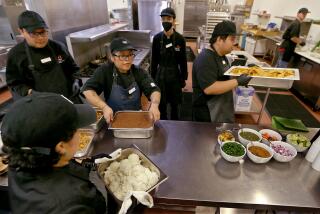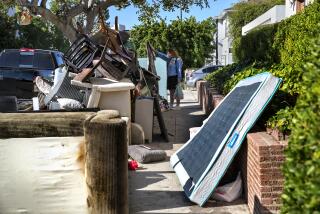All you can carry: College cafeterias go trayless
- Share via
Derek Owens performs a nifty and somewhat precarious balancing act when he gets his meals at Pomona College.
At lunch one recent day, the freshman from Oregon held a plate of nachos and beans in one hand. In the other, he stacked a serving of pizza and breadstick on top of a fruit juice cup. With silverware deftly added to the pile, he made it to his table without spilling a drop.
Call it eco-dining, or another sign of tough economic times in American academia. Pomona this fall joined a growing number of colleges in California and across the nation that have eliminated cafeteria trays in an effort to reduce food waste, cut water usage and save on energy bills.
Students’ reaction has been mixed, but Owens and others say they are adapting for the sake of the environment, their schools’ budgets and their own waistlines. If they can’t carry all the food they want in their first trip to the serving stations, they say, they will make one or two more. And if they wind up with fewer second helpings of granola or ice cream, so be it.
“It’s definitely difficult and a little bit inconvenient,” Owens said amid the hubbub of Pomona’s Gothic-style Frary Dining Hall. “But I like the intentions. The intentions are good, to be more aware of the environment and all that. So it’s a small sacrifice to make.”
The trayless college cafeteria is a growing trend, spreading from the Northeast and West Coast to the Midwest and South, said Joseph Spina, executive director of the National Assn. of College and University Food Services. Because it combines business savings with students’ interest in sustainability, the change is viewed as a “win-win,” he said.
His group does not have a definitive list of trayless schools, but food service companies report that many are shedding the plastic trays. Aramark Higher Education estimates that 60% of the 600 campuses it serves are trayless, and Sodexo Inc., which works at a similar number of schools, says about 40% have switched.
In California, no-tray schools include UC Irvine, UC Riverside, UC Santa Cruz, San Diego State, Loyola Marymount University and all five undergraduate campuses in the Claremont Colleges consortium to which Pomona College belongs. UCLA also expects to be trayless in at least two of its four big student dining halls this fall.
Elsewhere, the University of Minnesota, the University of Connecticut, Catholic University of America in Washington, D.C., and Middlebury College in Vermont have joined the movement.
Criticism -- and grumbling among students about economic goals hiding behind political correctness -- has triggered reversals of the policy at some schools.
Student complaints about inconvenience prompted Northern Michigan University to abandon its plan to eliminate trays, at least for now.
Michigan students, along with those in other snow states, often turn their trays into makeshift sleds -- a time-honored tradition. School officials said that if they do make the switch next year, they might give the trays to students, expecting that many will be used for that purpose.
Many colleges offer dining plans that allow students to eat all they want at any meal; trayless schools typically maintain that tradition, although diners may not be able to carry all their food at once. Those schools report decreases of as much as 30% in food waste. With no trays to wash, they reduce water and energy use too.
Paul Melchior, director of dining services at San Diego State, said its annual food costs have been reduced about 2%, or $65,000, since the switch two years ago. He said the savings have gone mainly toward improved menus, including more fresh fish, prime rib and other upgraded items.
The change has also sped up the serving process, Melchior said. “Now they make a conscious choice of whether to go to that station and get that or not,” he said. “So the lines are significantly less.”
At UC Santa Cruz, which switched last year, about $100,000 in annual savings has helped moderate increases in students’ board plan fees, said Scott Berlin, director of dining and hospitality services.
Berlin cited a few minor downsides, including tables that need to be cleaned more often because of crumbs and scraps that otherwise would have fallen on trays, and students grousing about extra trips through the line. “Anything with sustainability and recycling requires you to do something extra and something more,” he said.
Miriam Feldblum, vice president and dean of students at Pomona College, said her campus and its food service contractor, Sodexo, experimented with “Trayless Tuesdays” last year and decided to go with it full time after positive feedback and changes in dining habits.
“When you ask people, ‘How often do you put something on your tray that you wind up not eating?’ they’ll think about it and say, ‘Quite often,’ ” she said. “It’s rare someone will say, ‘I eat everything on my tray.’ ”
At Frary Dining Hall, whose arches, wood paneling and chandeliers provide a “Harry Potter”-like atmosphere, Pomona junior Dylan O’Shea said the lack of trays causes him to “spill a fair share of food because I’m carrying too much stuff in one hand.”
So to cut down on the number of plates he was juggling on a recent afternoon, the biology major from Seattle piled six plums around his burritos and was considering a return trip to the serving stations for more grub. But he said he can live trayless: “Obviously, there are a lot of benefits because of the reduced waste.”
On the other hand, neuroscience major Clay Taylor supports the general concept of sustainability but said he considers the trayless change just a “trendy thing” to make the college appear environmentally conscious. The junior from Richmond, Va., said he wondered whether water was actually being saved, with students using more plates and tables needing extra cleaning.
In addition, Taylor said, he wasn’t pleased about having to make so many extra trips to get food: “The more time I spend on lunch, the less time I spend studying.”
--
More to Read
Sign up for Essential California
The most important California stories and recommendations in your inbox every morning.
You may occasionally receive promotional content from the Los Angeles Times.














